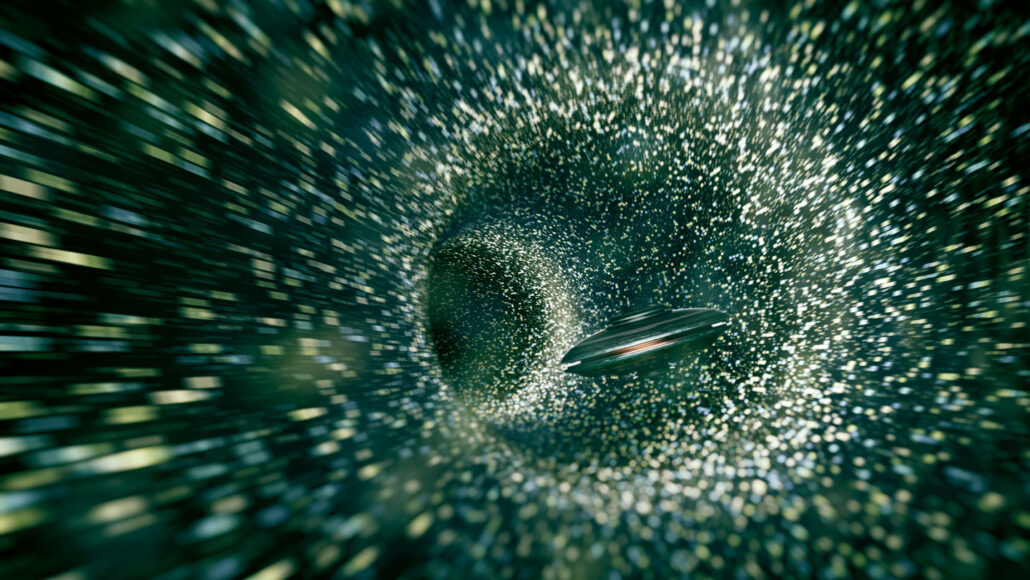Spacecraft traveling through a wormhole could send messages home
A model of these theoretical cosmic tunnels shows that wormholes don’t instantly snap shut

A spaceship diving into a wormhole (illustrated) could never return. But it might be able to send back video from the other side before the hole closes behind it.
gremlin/E+/Getty
If you ever happen to fall through a wormhole, you won’t be coming back. It will snap shut behind you. But on the way, you may have just enough time to send one last message home. That’s the finding of a new analysis.
A wormhole is a tunnel in the fabric of space. It would link two points in the cosmos. Wormholes are just theoretical. That is, scientists think they could exist, but no one has ever seen one. If they do exist, wormholes could provide shortcuts to distant parts of the universe. Or they might serve as bridges to other universes. There even may be multiple types of wormholes, each with different features.
One of the most commonly studied types of wormholes is thought to be highly unstable. Physicists have expected it would collapse if any matter entered it. But it wasn’t clear just how fast that collapse might be. Also unknown: What would it mean for something, or someone, heading into the wormhole?
Now, a computer model has shown how this type of wormhole would respond when something travels through it. Researchers shared the results in the November 15 Physical Review D.
In theory, says Ben Kain, you could build a probe and send it through. Kain is a physicist at the College of the Holy Cross in Worcester, Mass. “You’re not necessarily trying to get [the probe] to come back, because you know the wormhole is going to collapse,” Kain says. “But could a light signal get back [to Earth] in time before a collapse?” Yes, according to the model he and his colleagues have created.
No need for ‘ghost matter’
Some past studies of wormholes hinted that these cosmic tunnels could stay open for trips back and forth, Kain says. But in those studies, wormholes needed a special trick to stay open. They had to be supported by an exotic form of matter. Researchers call the stuff “ghost matter.”
Like wormholes, ghost matter is only theoretical. In theory, it would respond to gravity in exactly the opposite way that normal matter would. That is, a ghost matter apple would fall up from a tree branch instead of down. And ghost matter passing through a wormhole would push the tunnel outward, rather than pull it inward to collapse.
The existence of such “ghost matter” would not break the rules of Einstein’s general relativity. That’s the physics that describes how the universe works on large scales. But ghost matter almost certainly doesn’t exist in reality, Kain adds. So, he wondered, could a wormhole stay open for any length of time without it?
In his team’s model, Kain sent probes made of normal matter through a wormhole. As expected, the wormhole collapsed. The probes’ passage caused the hole to pinch shut, leaving something like a black hole behind. But it happened slowly enough for a fast-moving probe to send light-speed signals back to our side — just before the wormhole completely sealed off.
Possible, but plausible?
Kain doesn’t imagine ever sending people through a wormhole (if such tunnels were ever found). “Just the capsule and a video camera,” he says. “It’s all automated.” It would be a one-way trip for the probe. “But we can at least get some video seeing what this device sees.”
Sabine Hossenfelder is skeptical that such a thing would ever happen. She’s a physicist at the Munich Center for Mathematical Philosophy in Germany. Sending a space probe into a wormhole to report back requires the existence of things not yet proven, she says. “Lots of things you can do mathematically have nothing to do with reality.”
Still, Kain says, it’s worthwhile to learn how wormholes that don’t rely on ghost matter might work. If they can stay open, even for fleeting moments, they might someday point to new ways to travel throughout the universe or beyond.







